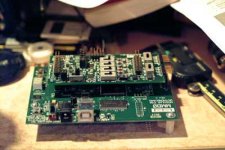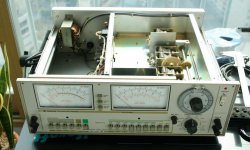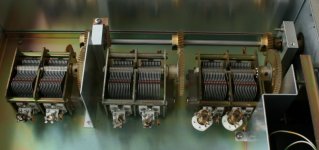Gasho said:What do you think about µcontroller (PIC, ATMega..) based function generators and distortion analyzer etc?
A garden variety microcontroller may not be fast enough, nor have sufficient memory -- that's why the specialty DSP chips from TI and Analog Devices are so interesting.
But with a microcontroller you can implement a really good sig gen -- the SG505 from Tektronix -- with programmable resistors -- the SG505 has THD% at or below 0.0004% Since you know the fundamental you can design a programmable notch filter to remove it for measurement. Noise is going to be your major bug-a-boo.
You also need to be able to HPF 400Hz -- gets rid of a lot of the ambient/environmental electrical noise -- and LPF above 80kHz.
To understand distortion, you need to see the harmonics. Measuring THD tells you nothing about the harmonic structure.
With a decent 24 bit sound card and good FFT software, you can do wonderful things. I would make the investment there first. It will do both clean signal generation and playback.
Yep, you need to watch signal levels going into the sound card - buy or build a wideband audio preamp and use that.
Probably the best general purpose FFT software is from Pioneer Hill, they sell a very basic version for about 300. with a 30 day free trial.
If you want free software, the best package is still Paul Kellets FFT software tools. If you need a link, shout.
It'd also amazing how inexpensive some of the great older FFT analyzers are nowadays. If anyone needs details on the older HP units, I can help. I know all of them pretty well, and still have a stock of data sheets and user guides for many of them. Starting with the HP3582. Before that, models like the 5423A and 5451C, well, you don't want to know.
Bob
With a decent 24 bit sound card and good FFT software, you can do wonderful things. I would make the investment there first. It will do both clean signal generation and playback.
Yep, you need to watch signal levels going into the sound card - buy or build a wideband audio preamp and use that.
Probably the best general purpose FFT software is from Pioneer Hill, they sell a very basic version for about 300. with a 30 day free trial.
If you want free software, the best package is still Paul Kellets FFT software tools. If you need a link, shout.
It'd also amazing how inexpensive some of the great older FFT analyzers are nowadays. If anyone needs details on the older HP units, I can help. I know all of them pretty well, and still have a stock of data sheets and user guides for many of them. Starting with the HP3582. Before that, models like the 5423A and 5451C, well, you don't want to know.
Bob
here's the links to the stuff above
Pioneer Hill Software - I think it's the best for the $
http://www.spectraplus.com/index.html
Paul Kelletts Wavetools - You gotta download and try this - free is for me!
"Oscilloscope - a dual-channel storage oscilloscope
Spectrum Analyzer - a narrowband spectrum analyzer. The display shows level (Y-axis) against frequency (X-axis)
Audio Meter - provides stereo peak meters, stereo RMS (average) meters, phase correlation meter, vectroscope and peak hold.
Signal Generator - produce test tones from 20 Hz to 20 kHz plus white and pink noise. 1/3-octave band frequencies and musical notes (based on A440) can be directly selected from the menu."
http://web-ee.com/downloads/signal_processing/
Here's another one I like and is free - Audacity. You can use it to generate pure sine tones, then save them to disk, and burn a CD full of different frequencies. The editing allows you yo make sine bursts, etc. or even mix multi-tones together. You can highlight a section of the waveform and use the analyze function to see up to a 16K FFT
http://audacity.sourceforge.net/
Before buying a fancy sound card, try the one you have - likely you'll get spur free dynamic range of at least 90-95dB or better for generation and capture. An old late 90's laptop that is too slow for most things today is perfect for this sort of thing.
You may wonder what I use day to day? An Ono-Sokki CF-6400, HP3562A, and my newest personal buy (toy), an HP54522A 500MHz scope with great FFT capability.
Bob
Pioneer Hill Software - I think it's the best for the $
http://www.spectraplus.com/index.html
Paul Kelletts Wavetools - You gotta download and try this - free is for me!
"Oscilloscope - a dual-channel storage oscilloscope
Spectrum Analyzer - a narrowband spectrum analyzer. The display shows level (Y-axis) against frequency (X-axis)
Audio Meter - provides stereo peak meters, stereo RMS (average) meters, phase correlation meter, vectroscope and peak hold.
Signal Generator - produce test tones from 20 Hz to 20 kHz plus white and pink noise. 1/3-octave band frequencies and musical notes (based on A440) can be directly selected from the menu."
http://web-ee.com/downloads/signal_processing/
Here's another one I like and is free - Audacity. You can use it to generate pure sine tones, then save them to disk, and burn a CD full of different frequencies. The editing allows you yo make sine bursts, etc. or even mix multi-tones together. You can highlight a section of the waveform and use the analyze function to see up to a 16K FFT
http://audacity.sourceforge.net/
Before buying a fancy sound card, try the one you have - likely you'll get spur free dynamic range of at least 90-95dB or better for generation and capture. An old late 90's laptop that is too slow for most things today is perfect for this sort of thing.
You may wonder what I use day to day? An Ono-Sokki CF-6400, HP3562A, and my newest personal buy (toy), an HP54522A 500MHz scope with great FFT capability.
Bob
I like the clicking of the relays on my AP -- it's hooked into an HP3577
I have an extra Boonton 1120 which I would part with ....
I have an extra Boonton 1120 which I would part with ....
A very nice network analyzer, the "big brother" to the 3562A, both built by HP Lake Stevens in the early 80's.jackinnj said:I like the clicking of the relays on my AP -- it's hooked into an HP3577
Not for distortion, right? Or are you doing something tricky? I recall it has 1M ohm inputs well as 50 ohm. But my no spectrum analyzer mode like the 3585 has. Great for impedance of caps, sweeping filters, circuits etc out to 200MHz.
BTW, the 3562A is one of the few units with a fully differential floating input, great for testing digital amps with a floating output. You don't want to connect the minus speaker output of most digital amps to ground - or you may let the smoke out, (or trip the protection if it has it).
I live in fear of blowing out the front end of the '3577 -- use multiple latex devices for protection 🙂
There's a USB-VNA in the Jan/Feb issue of QEX by DG8SAQ -- uses a pair of AD9859 DDS chips, some NXP SA612's etc., etc. I would like something to look at more power supplies, etc.
There's a USB-VNA in the Jan/Feb issue of QEX by DG8SAQ -- uses a pair of AD9859 DDS chips, some NXP SA612's etc., etc. I would like something to look at more power supplies, etc.
jackinnj: " ... TI just sent me the schematic for the MMB0 motherboard ..."
I just ordered the TI kit ( http://focus.ti.com/docs/toolsw/folders/print/ads1271evm-pdk.html )
... I'm surprised they don't include the MMB0 motherboard with it 😱
Now I guess I'll have to build it. 🙄
If you could find it in your heart to make more than one, I would gladly pay my end ... (My days of soldering small pads are numbered, and surface mount stuff = fagetaboutit.) I can also send along any special USB parts you might need:
 ... want some? email me as I am a distributor of these and many more such.
... want some? email me as I am a distributor of these and many more such.
I just ordered the TI kit ( http://focus.ti.com/docs/toolsw/folders/print/ads1271evm-pdk.html )
... I'm surprised they don't include the MMB0 motherboard with it 😱
Now I guess I'll have to build it. 🙄
If you could find it in your heart to make more than one, I would gladly pay my end ... (My days of soldering small pads are numbered, and surface mount stuff = fagetaboutit.) I can also send along any special USB parts you might need:
PDK = got it coming ( TLV320AIC32EVM-PDK ... right? )... Still puzzled that TI didn't make the suggestion as an option when ordering the first kit ...
Thanks a bunch ...
(Anyone have experience running the software in a Windows window on a current Mac?)
Thanks a bunch ...

(Anyone have experience running the software in a Windows window on a current Mac?)
The TI Kit ( http://focus.ti.com/docs/toolsw/folders/print/ads1271evm-pdk.html ) DOES INCLUDE the MMB0 motherboard w/USB connector as a peripheral (type B connector) = just got it ... now all I have to do is build the +/- 15 vdc & +5 vdc power supply (I don't want the switching noise from my cpu to interfere with the signal) ... 

Congrats.
There are quite a few suppliers of after-market programming goodies for the Texas Instruments DSP PDK's...Softbaugh is one.
There are quite a few suppliers of after-market programming goodies for the Texas Instruments DSP PDK's...Softbaugh is one.
Bought this at about USD65 🙂
It's National distortion meter VP-7702C.
It's with a transformer of primary 110VAC 🙁
No user manual
I don't know how to use this
Wife doesn't understand this buying, and looking at me as mad
I opened the cover to see any possibility for me to switch the primary from 110VAC to 220VAV . . .
Any tip . . . ?
>>🙂<<
It's National distortion meter VP-7702C.
It's with a transformer of primary 110VAC 🙁
No user manual

I don't know how to use this

Wife doesn't understand this buying, and looking at me as mad

I opened the cover to see any possibility for me to switch the primary from 110VAC to 220VAV . . .
Any tip . . . ?
>>🙂<<
Attachments
From the Koreans: http://www.triode.co.kr/zbxe/?document_srl=59219 Nice internal pictures.
===
" Wife doesn't understand ...."
Mine either ... But I convinced Her that it was for my hobby that may someday turn into a vocation = a learning experience that I could never get from a school ...
===
" No user manual ..."
Well, just don't make any internal adjustments until you find out how and have a good reference source.
I will bet that you have to rewire the transformer to accomplish the 110 to 220 change over.
Get the transformer model numbers and do a web search ...
===
" Wife doesn't understand ...."
Mine either ... But I convinced Her that it was for my hobby that may someday turn into a vocation = a learning experience that I could never get from a school ...
===
" No user manual ..."
Well, just don't make any internal adjustments until you find out how and have a good reference source.
An externally hosted image should be here but it was not working when we last tested it.
I will bet that you have to rewire the transformer to accomplish the 110 to 220 change over.
Get the transformer model numbers and do a web search ...
The simplest method is to get an external step down transformer 220v to 110v and connect the instrument to that. That way you will be sure that you don't need to touch the insides of the instrument and 'possibly' let Murphy in.😀
That would be catastrophic and give enough reason for your wife to throw it out !
That would be catastrophic and give enough reason for your wife to throw it out !

Mmmmm .... something like this: http://video-camera-center-inc.amazonwebstore.com/Seven-Star-Step-Up-and-Down/M/B000AY72DO.htm ... US$22.00 plus tax, license and shipping. More or less in Busan, yes / no ?
500 watts = ~ 2 Amps @ 220 VAC ... From the looks of the pictures, I would say that's plenty. Check the fuse size before proceeding ...
(You might also check the folks that posted this: http://www.triode.co.kr/zbxe/?document_srl=59219 ... for a copy of their manual.)
500 watts = ~ 2 Amps @ 220 VAC ... From the looks of the pictures, I would say that's plenty. Check the fuse size before proceeding ...

(You might also check the folks that posted this: http://www.triode.co.kr/zbxe/?document_srl=59219 ... for a copy of their manual.)
FastEddy said:
(You might also check the folks that posted this: http://www.triode.co.kr/zbxe/?document_srl=59219 ... for a copy of their manual.)
According to the reading, he has no manual either

But, he has switched jumper wire for 220Vac use.
So, I have just sent a mail to him

>>🙂<<
The ganged variable capacitor sets the "null" at the fundamental frequency (least that's what the ancient heathkit I had did).
BFNY said:here's the links to the stuff above
Pioneer Hill Software - I think it's the best for the $
http://www.spectraplus.com/index.html
Bob
Uhhh… I doubt, have looked around that site: You need a big buck of $$ for that
 I wonder if it brings you any more in the end than ARTA and AUDIOTESTER for 1/10 to 1/40 of the price.
I wonder if it brings you any more in the end than ARTA and AUDIOTESTER for 1/10 to 1/40 of the price.Your limitation is the soundcard in the end.
Cheers 😉
- Status
- Not open for further replies.
- Home
- Design & Build
- Equipment & Tools
- distortion analyzer recomendations?


